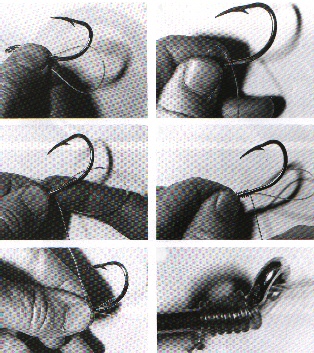
Blood Knot
A popular knot for tying line to hooks as any decrease the knot causes to the breaking strength of the line is minor. This knot is formed by passing the line through the eye of the hook, then returned and wound around the line five times. It is then returned again through the loop against the eye of the hook, back through the loop which is formed when the line passes through the loop against the eye. The knot is then pulled tight and the loose end trimmed with a knife or pliers.

Snood Knot
This knot is used for flatted and ringed hooks. The Snood is tied by forming a fairly large loop at the end of the line and holding the loop along the shank with the cut end of the line flush with the bend of the hook. The knot is loosely tightened by pulling from each end of the line and is pushed up to the eye or the flat of the hook before the final pressure is applied. For ringed hooks, the line is usually passed throught the eye before the knot is formed. A common use for the Snood knot is for tying a hook to running lures, such as feather jigs. The Snood allows the ring of the hook to settle against the head of the feathers instead of being separated by a knot. The Snood is a very secure knot and tightens under pressure.

Note: Steps 1, 2, 3 are on the left descending, while steps 4, 5, 6 are on the right descending.
 |  |